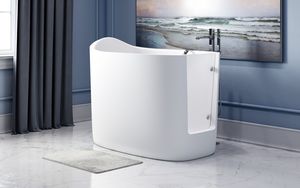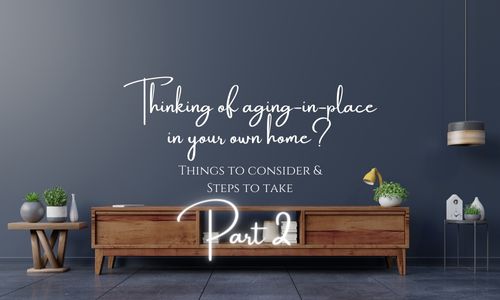Part 2
If you have decided to stay in your own home as you age, you are doing it at a good time! Technology has made aging-in-place easier than it has ever been—and that technology will probably continue to improve at exponential rates. In addition, companies cashing in on the massive Baby Boomer generation are pumping out new products constantly.
Good Lighting
Make sure that there is adequate lighting for doing tasks in specific areas. Good overhead lighting and accent lighting is preferable. Something I never thought about until doing research for this post —the lighting you use should be one that shows your true skin color to gauge healthy pallor. LED and halogen lights are good choices due to their 5000 Kelvin rating. I learn something new every day. 😊
Flooring
Non-slip flooring is a must. Area rugs are not recommended, but if you are like me you can’t live without them. Make sure they are firmly anchored down with non-slip pads or double sided tape, and check all the edges to make sure they aren’t curling up and causing a trip hazard.
Matte Surfaces & Light Colored Surfaces
We already talked about non-slip flooring, but what about other surfaces? Benefits to matte surfaces on areas such as countertops or other work surfaces are less slippage (especially when wet) as well as less glare for people with macular degeneration. Light colored surfaces with very little pattern allow those with older eyes to easily see crumbs, medication, etc. easily.
Zero Thresholds
Even the smallest change of elevation in a floor at a threshold can be a trip hazard or make it difficult to navigate with a walker or wheelchair. Tricky places they hide are the entry to a shower and garages. Eliminating thresholds when you install new flooring or remodel your bathroom is a super idea, even if you think you won’t have mobility issues.
Grab Bars
Generally a pretty easy thing to add—and again, new options on the market are much more stylish than the old style of grab bars from the 1980’s.
Walk-in Tubs
I love taking baths and I don’t see that changing anytime soon! It’s amazing how nice some of the walk-in bathtubs are now!

Tub and image from Aquaticausa.com
Faucets/Plumbing
Touchless faucets are great for those with arthritis or other issues, but even just replacing old turn knobs for levers can make a big difference. Thermostatic valves (anti-scald valves) should also be considered to avoid burns—or turn your hot water heater down.
Wall Mounted Sink in Bathroom
This is a great idea if you are remodeling your bathroom as a wheelchair can fit under it.
Toilet
An elevated toilet is much easier for older people or those with mobility issues to use. There are aftermarket raised toilet seats that you can buy in lieu of replacing the whole toilet. Don’t forget grab bars near the toilet also.
Shower
An ideal situation would be a walk-in shower with a zero threshold entrance, grab bars and built-in seating. Make sure you include a handheld shower in addition to an overhead showerhead.
Doorways
Doorways should be 32-36 inches wide. Make sure all entrances and exits are well-lit, and uncluttered. Handles should be lever style, not knobs.
Furniture
When planning furniture for aging in place think items like rounded corners, no glass topped tables, light but sturdy dining chairs, and chairs that are easy to get in and out of. Please remember never to block any exits with furniture or other items! One furniture item that is a must for those aging-in-place (and those vertically-challenged such as myself!) is a good solid step-stool. Safety first—this is not the time to chintz out and buy a cheap product.
Fall Detection and Medical Alert Devices
Advances in tech have made these products pretty amazing. You may want to consider one, especially if you live alone or have health issues. Here are some comparisons of medical alert and fall detection devices from the National Council on Aging.
Get Your Plans in Place
In addition to home modifications, having a support system in place in the way of friends, family, neighbors or others is crucial. Make sure your neighbors know who to contact in an emergency. Do you have pets? Have a contingency plan in place should you need to spend a night away or have a health issue that interferes with you taking care of them. Now is a good time to create a document that outlines their care in case someone needs to step in for a day or more. Do you have someone you know that can drive you where needed if you are unable to drive? Do you have someone to call or text for a quick daily “check-in” if you live alone?
Taking Care of Yourself
A huge determining factor of whether or not you will be able to stay in your home as you get older is your health. You can have your home tricked out with every age-in-place accoutrement, but if your health is suffering there is more chance that you will eventually need more than in-home care. This is the time to take a good look at your diet, exercise and other habits. Flexibility is more important as you age than running five miles—so maybe consider incorporating yoga into your routine. Eating meat seven days a week? Consider swapping a few burgers out for plant-based meals. Don’t sit on the couch and watch TV or endlessly scroll on your device—find out what activities you are passionate about and start doing them. Get involved with volunteering—you have a lot of life experience and talents that can help others! Go easy on the alcohol and quit smoking if you still do. Laugh as much as possible and enjoy this beautiful chapter of your life! 🥰
Want some visual inspiration? Head on over to a Pinterest Board we created with some ideas for making your home age-in-place ready!
If you are looking for a home to age-in-place in, please contact us anytime! We would love to help you find the perfect place! Want to sell your current home? From preparing and staging your property to the final closing and beyond—we are ready to assist!


